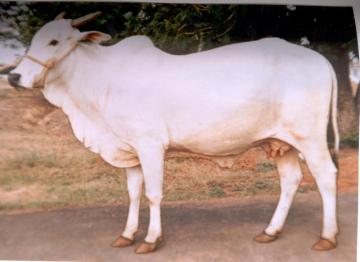Ongole
Ongole is a prominent dual purpose breed of Andhra Pradesh. The breed got its name from its geographical area of origin, i.e. Ongole. The breed is also known as “Nellore” as the Ongole area was earlier in Nellore district. The breeding tract of the breed includes East Godavari, Guntur, Ongole, Nellore and Kurnool districts of Andhra Pradesh and extends all along the coast from Nellore to Vizianagram. The breed is known for hardiness, disease resistance and capacity to thrive on scanty resources. Animals of the Ongole breed were extensively exported to USA for beef production; Brazil for beef and milk production; Sri Lanka, Fiji and Jamaica for draught; Australia for heat tolerance and beef; and Switzerland for disease resistance. The breed has glossy white coat colour. Males possess dark markings on head, neck and hump and black points on knees and pastern. Horns are short and stumpy, growing outward and backward from the outer angles of the poll, thick at the base and firm without cracks. In cows, horns are thinner than bulls. Horns in cows generally extend outward, upward and inward. Breed can be identified visibly by its majestic gait, stumpy horns and large fan shaped and fleshy dewlap. The breed produces moderate milk with an average of 798 kg per lactation and with an average fat percentage of 3.79%.
For further details, please follow below given link:
http://14.139.252.116/agris/breed.aspx
Compiled by Animal Breeding Group, NDDB from Information System on Animal Genetic Resources of India (AGRI-IS)- developed at National Bureau of Animal genetic Resources, Karnal, Hariana, India.

Comments
Post a Comment